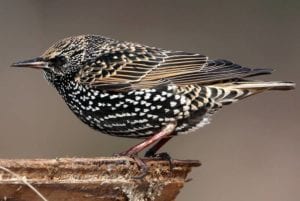You may be looking at this article because you recently have starling problems. In the short article we are going to share with you what are some common solutions for starling problems.
Prevention
It’s best to keep starlings out before they start to build their nest. Ask yourself, “Have they nested in a vent before?” “Is there a cavity on the house they might like?” Seal any openings before they appear and start building. If you discover them building before eggs are laid, remove the nest and appropriately cover the opening they were using.
Sealing openings
Use hardware cloth, metal flashing, or commercial vent covers to seal opening, (the commercially available ones are probably the easiest to work with). Lighter material, such as plastic netting or window screening, rarely keeps determined starlings out. Any vent covering you use for starlings should be checked periodically to make sure the vent is working properly and is not impeded by a build-up of any material, such as lint from a dryer.
Identifying an active nest
You’ll know there are chicks in the nest when you hear the sound of begging nestlings. Active nests are also often marked by a fan-shaped trail of smeared droppings below a corner joint or other entrance to a cavity. Birds using vents make noise that the vent itself tends to amplify. Act right away if you hear scratching and shuffling.
Nests in building cavities and vents
Starlings will use any hole they can get into if it leads to a suitably sized cavity. Dryer, stove, and bathroom vents are ideal. A vent with a metal flap may not deter them: they can hover or perch while raising the flap to get into vents.
Vents with nests inside may not function properly. This can be inconvenient or, in some cases, unsafe. The nesting material may need to be removed immediately.
Sometimes young starlings get caught in vents, falling into open spaces that they can’t escape. This may be especially true of microwave and stove hood exhaust vents. To help a starling out of one of these vents, you may need to remove the hood or microwave, so you might want to call a professional.
If eggs or young are already in the nest, can this vent be left unused until they fledge? If so, treat this nest like a nest in an attic or similar cavity.
Nests in attics and similar cavities
If you find eggs or young birds in attics or similar cavities, leave them be. You may have to wait about 12 days for eggs to hatch and up to 3 weeks for young to leave the nest. Check the nest frequently—once the young leave the nest, remove the nesting material, and seal the openings.
Removing the nest
If young are present in a vent or other space, and there is no option to leave them there until they fledge, the parents can still raise their young in an alternate nest.
- Make a substitute nest from a wicker basket, a plastic gallon jug, or a birdhouse designed for medium-sized woodpeckers.
- Cut an U shape opening in the plastic jug and flip the “door” up to keep rain out.
- Attach the substitute nest as close as possible to the original nest, but in as much shade as possible.
- Carefully remove nesting material and nestlings, and place in substitute nest.
Noisy nestlings usually attract the parents who will continue to care for them. Watch the substitute nest to see that the adults return. They should not take more than a half hour or so, as growing young birds need constant feeding. If the adults do not return to nestlings, contact a wildlife rehabilitator in your area for advice.
Finally and importantly, if it was a vent that you vacated, promptly install a vent cover to keep other starlings, and other birds, out.
At Pigeon Patrol, we manufacture and offer a variety of bird deterrents, ranging from Ultra-flex Bird Spikes with UV protection, Bird Netting, 4-S Gel and the best Ultrasonic and audible sound devices on the market today.
Contact us at 1- 877– 4– NO-BIRD, (604) 585-9279 or visit our website at www.pigeonpatrol.ca for your starling problems.
Bird Gone, Pigeon Gone, Seagull Gone, Pigeon issue, pigeon spikes, 1-877-4NO-BIRD, 4-S Gel, Bird Control, Pigeon Control, bird repellent, Bird Spikes, sonic bird repellent, stainless steel bird spikes, bird spikes Vancouver, Ultra Sonic Bird Control, Bird Netting, Plastic Bird Spikes, Canada bird spike deterrents, Pigeon Pests, B Gone Pigeon, Pigeon Patrol, pest controller, pest control operator, pest control technician, Pigeon Control Products, humane pigeon spikes, pigeon deterrents, pigeon traps, Pigeon repellents, Sound & Laser Deterrents, wildlife control, raccoon, skunk, squirrel deterrent, De-Fence Spikes, Dragons Den, Canada bird spikes, Canada pigeon, pigeon control, pigeon patrol, pigeon. Kill pigeons, crow, starling
